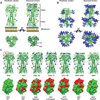Cross-neutralization of 1918 and 2009 influenza viruses: role of glycans in viral evolution and vaccine design
- PMID: 20375007
- PMCID: PMC3182573
- DOI: 10.1126/scitranslmed.3000799
Cross-neutralization of 1918 and 2009 influenza viruses: role of glycans in viral evolution and vaccine design
Abstract
New strains of H1N1 influenza virus have emerged episodically over the last century to cause human pandemics, notably in 1918 and recently in 2009. Pandemic viruses typically evolve into seasonal forms that develop resistance to antibody neutralization, and cross-protection between strains separated by more than 3 years is uncommon. Here, we define the structural basis for cross-neutralization between two temporally distant pandemic influenza viruses--from 1918 and 2009. Vaccination of mice with the 1918 strain protected against subsequent lethal infection by 2009 virus. Both were resistant to antibodies directed against a seasonal influenza, A/New Caledonia/20/1999 (1999 NC), which was insensitive to antisera to the pandemic strains. Pandemic strain-neutralizing antibodies were directed against a subregion of the hemagglutinin (HA) receptor binding domain that is highly conserved between the 1918 and the 2009 viruses. In seasonal strains, this region undergoes amino acid diversification but is shielded from antibody neutralization by two highly conserved glycosylation sites absent in the pandemic strains. Pandemic HA trimers modified by glycosylation at these positions were resistant to neutralizing antibodies to wild-type HA. Yet, antisera generated against the glycosylated HA mutant neutralized it, suggesting that the focus of the immune response can be selectively changed with this modification. Collectively, these findings define critical determinants of H1N1 viral evolution and have implications for vaccine design. Immunization directed to conserved receptor binding domain subregions of pandemic viruses could potentially protect against similar future pandemic viruses, and vaccination with glycosylated 2009 pandemic virus may limit its further spread and transformation into a seasonal influenza.
Conflict of interest statement
Figures



References
-
- World Health Organization. Geneva: World Health Organization; 2009. DG Statement following the meeting of the Emergency Committee. http://www.who.int/csr/disease/swineflu/4th_meeting_ihr/en/index.html.
-
- Garten RJ, Davis CT, Russell CA, Shu B, Lindstrom S, Balish A, Sessions WM, Xu X, Skepner E, Deyde V, Okomo-Adhiambo M, Gubareva L, Barnes J, Smith CB, Emery SL, Hillman MJ, Rivailler P, Smagala J, de Graaf M, Burke DF, Fouchier RA, Pappas C, Alpuche-Aranda CM, López-Gatell H, Olivera H, López I, Myers CA, Faix D, Blair PJ, Yu C, Keene KM, Dotson PD, Jr, Boxrud D, Sambol AR, Abid SH, St. George K, Bannerman T, Moore AL, Stringer DJ, Blevins P, Demmler-Harrison GJ, Ginsberg M, Kriner P, Waterman S, Smole S, Guevara HF, Belongia EA, Clark PA, Beatrice ST, Donis R, Katz J, Finelli L, Bridges CB, Shaw M, Jernigan DB, Uyeki TM, Smith DJ, Klimov AI, Cox NJ. Antigenic and genetic characteristics of swine-origin 2009 A(H1N1) influenza viruses circulating in humans. Science. 2009;325:197–201. - PMC - PubMed
Publication types
MeSH terms
Substances
Associated data
- Actions
- Actions
- Actions
- Actions
- Actions
- Actions
- Actions
- Actions
Grants and funding
LinkOut - more resources
Full Text Sources
Other Literature Sources
Medical

